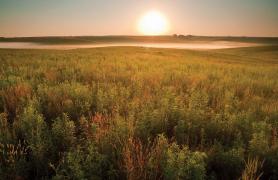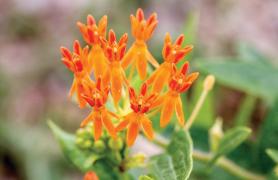Trumpeter Swan
A friend called to let me know there was a bevy of over 70 trumpeter swans on his Grand River wetland in Livingston County. He said they had been coming there for years, but this was the largest gathering he could remember. It was after duck hunting season in the North Zone, so he invited me to photograph the swans using his hunting blind so I could stay hidden and out of the biting January wind.
After parking by a grain bin in the predawn light, I trudged to the blind clad in waders and a heavy coat knowing that I would be sitting still for quite a while. The sticky river bottom mud, known as “gumbo,” clung to my boots in balls making my footing precarious as I approached the shallow wetland basin between corn and soybean fields. It was a spot that flooded readily, so the farm owners, Randy Price and his son, Ben, decided to work with nature and converted a portion of their crop fields into a wetland with a permanent hunting blind.
The swans paddled around the water as the sun rose, using their webbed feet to dig into the mud and churn up aquatic plants to eat. They would jump off the water in bunches of five or 10 and circle the area, occasionally flying to the cover of a wooded hillside in the distance. Trumpeter swans (Cygnus buccinator) are listed as uncommon to rare, but they are being seen more often as reintroduction efforts gain traction. They range from the Bering Strait, across Canada, and as far south as Missouri and Illinois. The U.S. Fish and Wildlife Service estimates there are 16,000 trumpeter swans in North America, with only a few thousand around the Midwest. They are big birds that can have a wingspan up to 8 feet and weigh over 20 pounds. They are the largest waterfowl in North America and the largest swan in the world. It is important to note that these birds are a species of conservation concern and are sometimes mistaken for snow geese (Chen caerulescens) by hunters even though swans are significantly bigger and heavier, with a much longer neck. Killing a trumpeter swan could result in a significant fine.
I noticed one of the swans had a neckband, so I decided to see what I could find out about it. A quick online search for trumpeter swans with yellow neckbands marked in black with a number-numberletter sequence ending in “N” indicate that this swan was captured and banded in Wisconsin.
I photographed for a few hours until the light got too harsh to manage with my camera. It was a really relaxing morning out on the water enjoying such a big group of these birds. Their gentle nature and low honking call was soothing, and it was a great reason to be outdoors on the water.
—Story and photograph by David Stonner
We help people discover nature through our online Field Guide. Visit mdc.mo.gov/field-guide to learn more about Missouri’s plants and animals.


Also In This Issue


And More...
This Issue's Staff
Art Director - Cliff White
Associate Editor - Bonnie Chasteen
Staff Writer - Heather Feeler
Staff Writer - Kristie Hilgedick
Staff Writer - Joe Jerek
Photographer - Noppadol Paothong
Photographer - David Stonner
Designer - Les Fortenberry
Designer - Marci Porter
Designer - Stephanie Thurber
Circulation - Laura Scheuler






















